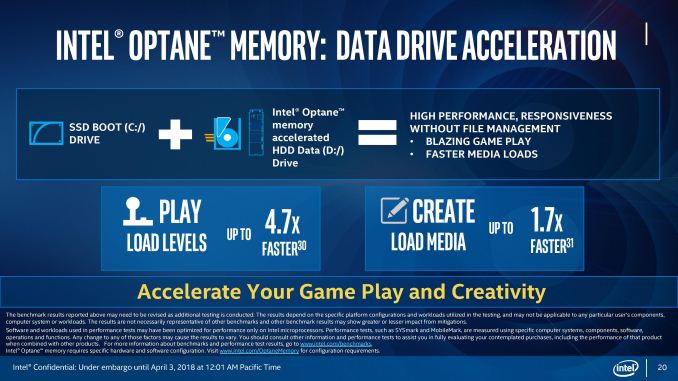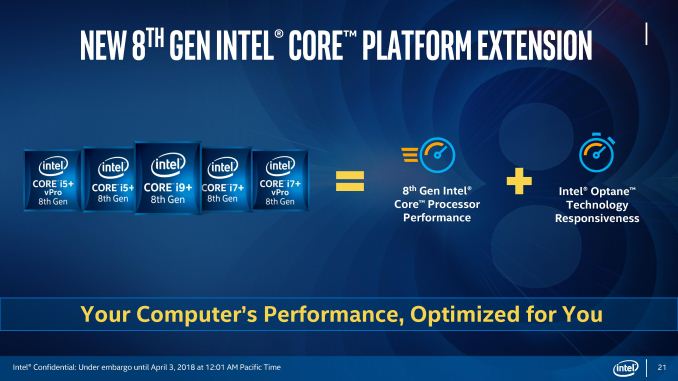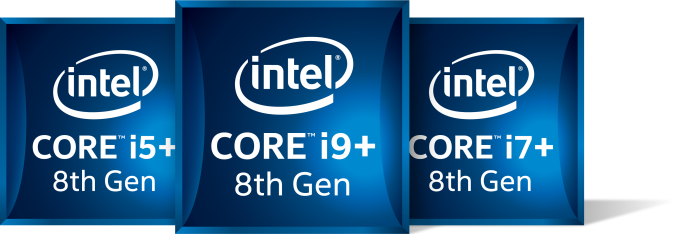Intel Expands 8th Gen Core: Core i9 on Mobile, Iris Plus, Desktop, Chipsets, and vPro
by Ian Cutress on April 3, 2018 3:01 AM ESTNew Optane Branding
Core i9+, Core i7+, Core i5+
One of the items that Intel is keen to promote with this launch is an update to its Intel RST algorithm when dealing with ‘Optane Memory’, Intel’s brand for Optane whereby a small amount of storage is placed in front of a larger drive to act as a fast cache. Up to this point, Intel platforms that supported Optane Memory in this configuration could only do so on the drive that was used to boot into the operating system. While this worked well for low-cost users that relied on a single rotational hard-disk drive of rust for their needs, with most enthusiasts using a fast SSD (SATA or PCIe) as their first drive that loads the OS, putting Optane Memory in front of this as a cache was relatively pointless – any gains would be intangible at best. With the new generation of products, Intel has expanded the capabilities of Optane Memory such that it can act as a cache for a non-OS drive. This means that a user can have a fast SSD boot drive, a large spinning drive for storage, and then place Optane in front of that storage drive to potentially get much better performance from the drive.
The main idea here is that the large rotational drive is where users store games and large files used in content creation, which often have a long loading time. With the right caching algorithm, and a decent sized Optane Memory drive, Intel likes to promote that loading games and loading media for creative purposes are several factors faster than an equivalent system without an Optane Memory drive.
Part of the news around Optane is that Intel is now creating new processor branding for OEMs that have configurations with Optane. The new brands and logos are similar to the standard Core i5/i7 style that we are used to, however the logos are now a dark blue with white text, and exhibit a plus after the Core i5/i7 name.
So just to be clear, this is not a new line of processors. We will not have to suddenly deal with a Core i9+-8950HK being different to the non-plus counterpart. This is purely a branding exercise, and one that only covers the i5 and higher at that. However, to complicate things, this means that specification sheets can (and will) list the processors as Core i5+ and Core i7+ and even vPro models. This makes looking for particular processor versions in search engines a lot more difficult for almost no obvious benefit. I mean sure, Intel wants to promote the use of its Optane drives, but we already have the Optane branding and the Optane logos to do that for us. This ends up being another logo put onto the box.
Ultimately, Intel is still marketing Optane, its high-cost R&D product, with low capacities at low cost systems with relatively little margin. While it might seem like a noble goal, to bring extra caching performance down to the lower cost segment, it could very easily be done with SATA or PCIe M.2 drives using regular NAND flash. A lot of users would like to see high-capacity, high-endurance Optane drives moving more into the mainstream, instead of more attempts at funneling in a product like Optane into caching.













123 Comments
View All Comments
BillBear - Tuesday, April 3, 2018 - link
Actually, we've already seen ARM chips surpass Intel in the server space where Intel is strongest.https://blog.cloudflare.com/arm-takes-wing/
FunBunny2 - Tuesday, April 3, 2018 - link
"2020 from Intel x86 CPUs to some sort of higher performance ARM processor "well, they could stamp 12 or 24 or 48 ARM cores on a chip, and call it a CPU. but that would mean they've abandoned single thread performance. it only makes sense if they've some secret multi-threaded sauce, built into macOS (or whatever they end up calling it), that runtime converts from single to multi. that's some Catch 22.
PeachNCream - Tuesday, April 3, 2018 - link
It sounds like the current intent is to consolidate under iOS across all of their computing devices. I do wonder how you'd reach a x86-comparable performance level with ARM cores. You're right they'd almost have to go crazy into multi-threaded stuff, but there are still some workloads that just don't benefit much. Like I said above though, I'm not really praising the move or particularly excited about it. It's just something that'd be interesting to watch happen.HStewart - Tuesday, April 3, 2018 - link
A non Intel based Mac will never replace high end mac - that may try it say MacBook Air line - but it likely be very unsuccessful.SaturnusDK - Tuesday, April 3, 2018 - link
You underestimate the baa! of the iSheep. They'll buy whatever crap Apple launches.serendip - Tuesday, April 3, 2018 - link
I was a Macbook and Powerbook user around the time of the PowerPC/x86 transition. Apple handled it well by having the Rosetta translation library; the Intel Core Duo chips back then had enough grunt to handle translated code at a decent speed too. It took a few years before big programs like Photoshop had native Mac Intel ports.An ARM Macbook with 20 hour battery life and Intel-equivalent performance would be a big seller provided code translation works well and popular apps have native ARM versions. Most Macbooks are used for Web and app development so it won't be hard to recompile code for ARM. I'd say Apple could do this better than the half-baked efforts by Windows OEMs to make Qualcomm PCs.
BurntMyBacon - Wednesday, April 4, 2018 - link
Are we talking low end Apollo Lake or high end Coffee Lake equivalent performance. The former isn't going to have compelling performance in anything beyond (perhaps) Web Apps. The later is a pipe dream. I don't much care for Intel as a company, but do you seriously believe they are so incompetent at designing processors that a company with only 8 year experience designing processors (Apple) is going to double battery life (Macbook) with the same performance while using translation? Catching up to Intel, while not easy, is doable. After all, many of the things Intel did to get to their current performance are now known quantities. Very suddenly passing Intel up doesn't seem plausible as that would require Apple to have design expertise Intel doesn't have. Very suddenly passing them up by such a wide margin ... well I hope it happens as it would spur on competition. However, hope is not in fact a strategy, so I'm not counting on it. More realistically, they could take the AMD approach of offering more cores and trading off single threaded performance for mult-ithreaded performance. That may make it compelling for some use cases.serendip - Wednesday, April 4, 2018 - link
20 hours based on the Qualcomm PCs which a few vendors have demoed. An Apple ARM chip could achieve similar battery life with similar x86 translation performance. If Qualcomm can do it, I would bet that Apple can too, especially as they control both hardware and software on their devices.fteoath64 - Thursday, April 5, 2018 - link
Not only this. Apple can add special "sauce" in TensorCore chips into the mix and moe specialised co-processors within the Arm CCN that Intel cannot really match. There is much to innovate in that space where Intel just went into "brute force" speed and power-savings just to market their chips over the last few generations. Apple's GPU expertise is also coming to speed so there is much hope there....HStewart - Saturday, April 7, 2018 - link
Using AMD for CPU is non-sense - it obvious that Intel has lead on AMD especially in the Mobile CPU and Apple has pretty much abandon the desktop area. Only with iMac Pro with monitor based iMac's are basically now mobile cpu because of size and power.